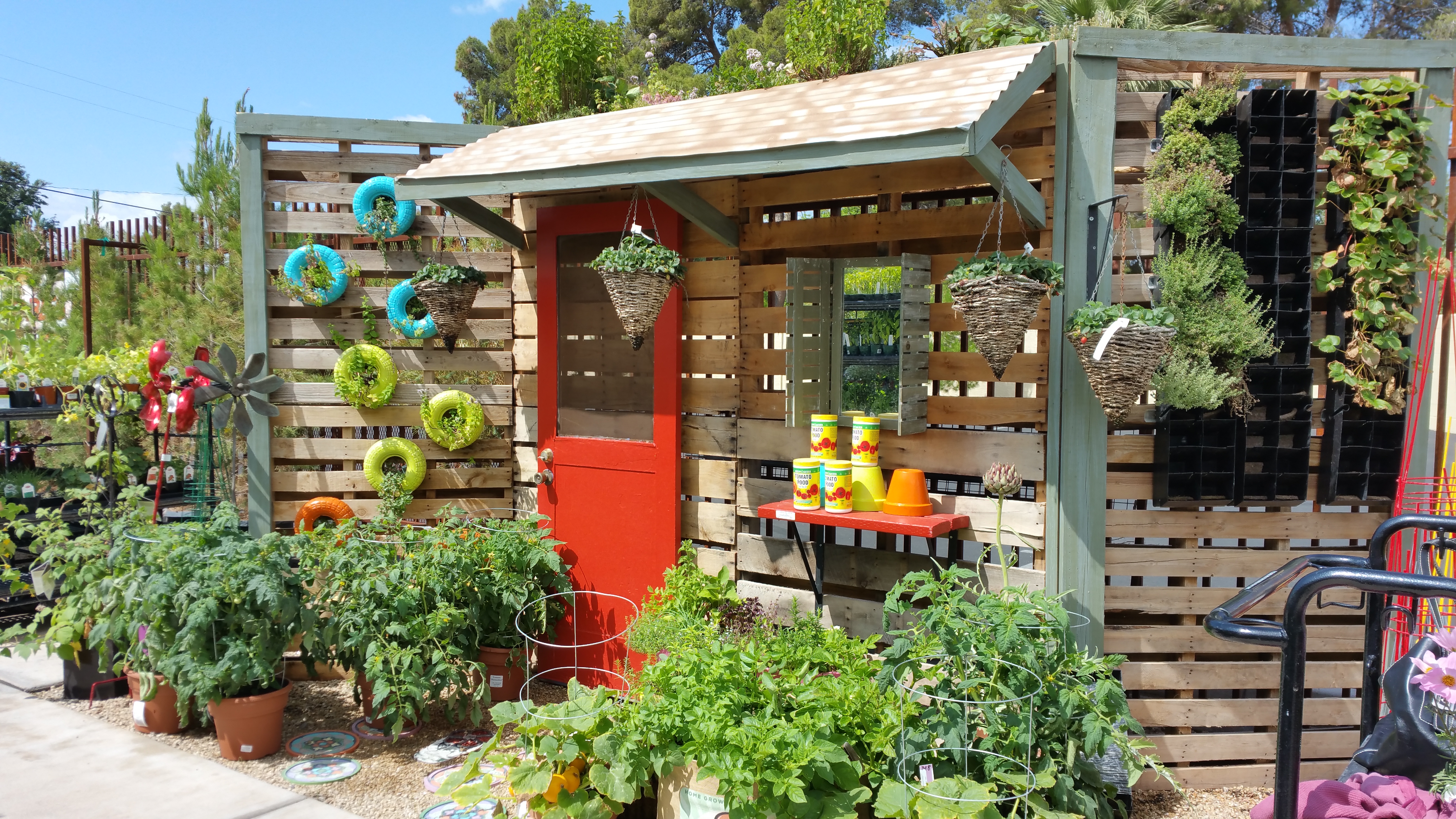Container Gardening in a Blast Furnace?
Gardening in Phoenix, AZ, where my farm is located, certainly has its challenges. From our alkaline mineral soil, to lack of adequate space, and, of course, a shortage of water and abundance of heat; I could have entitled this article “Successful Container Gardening in a Blast Furnace.”
But challenges are not unique to us. Though the problems vary, just about anywhere one lives, the gardener has to deal with soil, climate, water and pest issues.
Container gardening is a wonderful way to overcome these issues in order to grow beautiful ornamentals and productive edibles in our urban environment. Fun and easy for aspiring and seasoned gardeners alike, container gardens offer flexibility and manageability that in-ground gardens lack. In fact, the endless possibilities can make “pot culture” (growing plants in flower pots and other containers) addictive.
Choosing the Best Containers for Your Plants
In order to choose the best containers for your plants, the following questions need to be considered:
1. What do you want to grow? In general, the pot ought to be slightly wider and slightly taller than the mature size of the plant you want to grow. Tiny succulents can grow well in coffee cups or shallow bowls, but a tomato plant will need a lot more space (think “pregnant woman.”)
2. Drainage: The pot needs adequate holes in the bottom to allow for water to drain out of the pot.
3. Toxicity: Avoid growing edible plants in containers that are made of or once held toxic chemicals. Don’t used treated wood, as the preservatives may be toxic to plants, and harmful to humans, as well. (See this article on pallet gardens.)
Otherwise, anything that can hold soil can be a plant’s home.
Herbs are a wonderful starter plant for people who want to create a beautiful and edible container garden. They are easy to grow, and are some of the most expensive produce items at the store. The convenience of having them in your kitchen window or right outside your door is very satisfying.
Potting Mix Recipes for Flowers, Vegetables, Hanging Baskets, Bulbs and Succulents
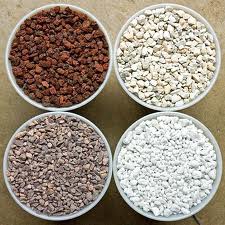 Clay soil from a southwest garden will not make good potting soil. They hold too much water, suffocating plant roots, and shrink when dry, pulling away from the sides of the pot. In other parts of the country, soil may be too sandy to too acidic. Use the “recipes” below, making sure that you select for purchase “potting” soil (not “garden” soil) from the nursery or hardware store.
Clay soil from a southwest garden will not make good potting soil. They hold too much water, suffocating plant roots, and shrink when dry, pulling away from the sides of the pot. In other parts of the country, soil may be too sandy to too acidic. Use the “recipes” below, making sure that you select for purchase “potting” soil (not “garden” soil) from the nursery or hardware store.
Cactus, Succulent and Bulb Mix
- 2-3 parts pumice
- 1 part potting soil
All-Purpose Mix
- 2 part potting soil (or 1 part compost)
- 1 part pumice or perlite
- 1 part sphagnum peat moss or vermiculite
Lightweight Mix for Hanging Baskets
- 2-3 parts pumice
- 1 part potting soil
- 1 part compost (optional)
Potting Soil Amendments for Container Gardens
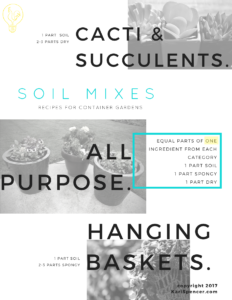 Get these recipes sent to your inbox.
Get these recipes sent to your inbox.
Organic Potting Soil Mixes
A great potting soil is the foundation for a successful container garden. Look for an organic option that is free of synthetic chemicals, that provides good draining and organic matter to provide your plants with nutrients.
Choosing a Healthy Plant at the Nursery
How to Choose a Healthy Plant at the Nursery
1. Choose a plant that looks “happy,” not droopy, brown, yellow or broken.
2. Soil in the pot should be moist, neither too dry nor too wet.
3. Roots should not be visible. If they are coming through the holes in the bottom, the plant may have been in the pot too long. Gently tease the root ball out of the pot to ensure that the roots are not circling or girdled.
Container Preparation and Transplanting
1. Plantings should be made according to the planting calendar, at the same time that you would plant them in a regular garden.
Vegetable Planting Calendar for Maricopa County is an excellent Arizona veggie calendar. For other climates, use the web or consult your local Master Gardeners to find a planting calendar for your specific area.
2. Choose a plant that is in a pot of appropriate size.
3. Don’t bring home unwanted bugs or weeds. Many nursery pots contain spurge. Remove it and leave it behind.
4. Buy plants that have been propagated locally and are acclimated to your climate.
5. For Arizona gardeners, choose “short season” varieties of vegetables which will produce more quickly than “long season” vegetables.
Planting
1. Before filling your pot with soil, ensure that it has enough drainage holes. Add more, if necessary. Cover the holes with permeable screening to deter insects from making a home in your pots, and to prevent soil depletion. Old window screens or coffee filters work well.
 2. Fill the container to within 1 inch of the top. If transplanting, make a hole for the plant that is slightly wider and as deep as the root ball (don’t plant too deep! Exception: tomatoes.) Do not place fertilizer in the hole.
2. Fill the container to within 1 inch of the top. If transplanting, make a hole for the plant that is slightly wider and as deep as the root ball (don’t plant too deep! Exception: tomatoes.) Do not place fertilizer in the hole.
3. Gently turn the plant upside down and ease the root ball out of the nursery pot, being very careful not to damage the stem. Tease roots apart gently and place the plant in the hole. Make sure that the top of the root ball is level with the surrounding soil.
4. Return displaced dirt to the hole to fill in empty areas. Do not press or force the dirt into the hole.
5. Label with the name of the plant, date of planting, and days to harvest (if applicable.)
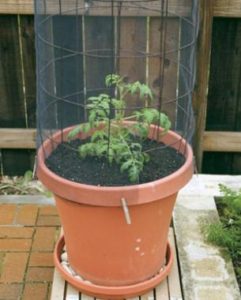 6. Gently water, being careful not to displace soil or seeds. The soil may settle, revealing low spots, or the plant may tilt to the side. Add a little bit more soil, as necessary, and water in again. Cover with mulch.
6. Gently water, being careful not to displace soil or seeds. The soil may settle, revealing low spots, or the plant may tilt to the side. Add a little bit more soil, as necessary, and water in again. Cover with mulch.
7. Thin seedlings when they have 2 leaves, spacing them according to the seed packet instructions.
8. If cages or other supports are needed, provide them when the plant is small.
How to Properly Water, Feed and Care For Container Plants
Watering:
Pots tend to dry out quickly, particularly small pots and clay pots. Water your plants until liquid runs out of the bottom of the pot to prevent salt build-up in your soil. To facilitate draining, place the pot on small legs or in a shallow dish filled with gravel. Allow the soil to dry before watering again (but not so much that the plant can’t recover!) Roots need air, so a water-logged plant will die just as quickly as a dehydrated plant. Too much water also encourages the growth of mildews and molds.
In the summer, you will have to water often. In order to help your plants survive the summer, elevate them off of a hot patio and cluster them so that they can shade each other with their foliage. Mulch the top of the soil with wood chips or pebbles to decrease evaporation and keep the soil cooler. Clay pots placed in full sun can get very HOT and bake your plants’ roots. Wrap the exterior with burlap, or “double pot” them to create airflow between the two pots.
Fertilizing:
Commercial potting soils generally have enough nutrients to last a couple of months. Following this initial period, add water soluble fertilizer according to the package instructions (I prefer to fertilize twice as often at half the recommended strength.) Do not over fertilize as plants can be “burned” by too much nitrogen. For optimum performance, refresh your pots annually with fresh compost or other organic material. Note that fertilizers list the big three nutrients (nitrogen, phosphorus and potassium) in the order N-P-K on their packaging (such as 15-11-8.) Flowering plants need phosphorus to bloom, so choose a fertilizer with a high 2nd number. Use a balanced blend for green plants and shrubs , such as 4-4-4. Acid loving plants will appreciate the addition of soil sulphur (coffee grounds are acidic, too.) Cactus and succulents only need to be fertilized once or twice each year, while they are growing.
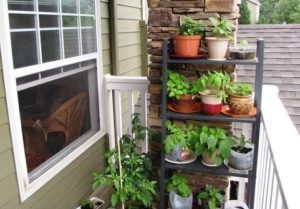 Light:
Light:
Choose the right plant for the amount of sunlight that your pot will receive. Some plants grow well in shady areas. Others, such as vegetables, require 6-8 hours daily of direct sunlight. Plants that require full sunlight in temperate areas may appreciate some afternoon shade in the summer. If your plant is too shaded, it may yellow or become “leggy” as it stretches to reach the sun. Sunburned plants turn yellow or brown. Move them, as necessary.
Salt damage:
Tap water tends to be high in salts, and container plants are particularly vulnerable to salt damage. Water deeply to prevent salt build-up in your pots. If you notice leaves with brown edges or tips, this is a sign of salt damage. Flush the pot well to wash salts away from the roots and out of the pot.
Care:
Keep an eye out for insects, particularly on vegetables. Remove them manually or chemically, if necessary. A solution of 3 tsp of Ivory dish soap to 1 gallon of water will deter many pests. Trim off dead or diseased plant material. “Dead head” flowers to encourage more blooms. Prune growing plants or move them to a bigger pot, if necessary. Refresh your pots annually with new soil and mulch, washing them with a 5% bleach solution between plantings.
Learn how to replant or refresh a container garden here.
Installing an (Optional) Automatic Watering System
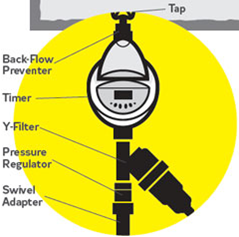
Container gardens can dry out very quickly, especially in the intense heat of the Phoenix summers. An automatic watering system will allow you to leave your plants for a vacation and prevent an “oops” if you are unable (or forget) to water. Consider automatic watering as a life-support system for your plants that will require some monitoring to ensure that it is working properly and watering at the correct rate. Occasional, deep hand watering may still be necessary for optimal plant health.
It is easy to add a drip system on a timer to your patio faucet. Kits are available at garden centers and big box stores, as well as irrigation stores. Some even provide clear plastic tubing that “fades” into the background. When you install your system, add an inexpensive timer that will turn the system on automatically at intervals that you set and are able to change as the seasons demand.
Fun and Creative Containers and Arrangements
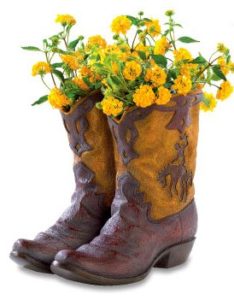 Just about any container that can hold soil and water can become a flower pot, from buckets and boots to bags and wine barrels. If it is impossible to add drainage holes to your container, place a slightly small pot inside the container, propped up on bricks for pebbles to allow for drainage.
Just about any container that can hold soil and water can become a flower pot, from buckets and boots to bags and wine barrels. If it is impossible to add drainage holes to your container, place a slightly small pot inside the container, propped up on bricks for pebbles to allow for drainage.
Note that metal containers are not recommended for plants that will be outside in the sun in hot climates. They tend to get too hot for tender container plants.
